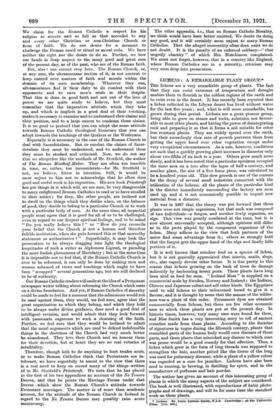LICHENS ; A REMARKABLE PLANT GROUP.* Tan lichens are a
very remarkable group of plants. The fact that they can resist extremes of temperature and drought
enables them to flourish in the coldest regions of the earth and to exist even in the desert. It has recently been reported that a lichen collected in the Libyan desert has lived without water for the last five years ; and, what is still more remarkable, has grown during that period. Lichens are a great pioneer group, being able to grow on stones and rocks, substrata not favour- able to most other plants, and having the power of disintegrating rock and preparing it so that it forms a soil suitable for other less resistant plants. They are widely spread over the earth, but their exceedingly slow rate of growth prevents them from getting the upper hand over other vegetation except under very exceptional circumstances. As a rule, however, conditions are such that.a quickly growing plant increases in diameter only about two-fifths of an inch in a year. Others grow much more slowly, and ithas been noted that a particular specimen occupied the same area on a tree after the lapse of half a century, and another plant, the size of a five franc piece, was calculated to be a hundred years old. This slow growth is one of the reasons for the decay of several small industries connected with the utilization of the lichens; all the plants of the particular kind in the district immediately surrounding the factory are soon used up, and it is not economically possible to import new material from a distance.
It was in 1867 that the theory was put forward that these plants were not simple organisms, but that each was composed of two individuals—a fungus, and another lowly organism, an alga. This view was greatly combated at the time, but it is now almost universally accepted, although opinions still differ as to the parts played by the component organisms of the lichen. Many adhere to the view that both partners of the union "find some advantage from it ; others as strongly hold that the fungus gets the upper hand of the alga and finally kills portions of it.
It is well known that reindeer feed on a species of lichen, but it is not generally appreciated that insects, snails, slugs, etc., also eagerly devour other forms. It is due partly to this reason that lichens growing on the bark of trees do damage indirectly by harbouring insect pests. These plants have long been used as food for man. " Iceland Moss " is supplied on a commercial scale by Sweden, Norway and Iceland ; the Indians, Chinese and Japanese collect and sell other kinds. The Egyptians used to add lichens to their unleavened bread to give it a flavour, and it is thought by some that the manna of the wilder- ness was a plant of this order. Permanent dyes are -obtained commercially from lichens, but there are few other -economic uses to which these plants are put at the present day. In historic times, however, very many uses were found for them, and Miss Smith has a very interesting story to tell of ancient remedies made from these, plants. According to the doctrine of signatures in vogue during •the fifteenth century, plants that resembled parts of the human body would cure diseases of those parts, and those plants that mimicked any disease to-which man was prone would be a good remedy for that affection. Thus, a lichen which grew in the form of long threads was supposed to strengthen the hair, another pitted like the tissue of the lung was used for ,pulmonary diseases, while.a plant of .a yellow colour was regarded as .11 cure for jaundice. Lichens have also been used in tanning, in brewing, in distilling for spirit, and in the manufacture of perfumes and hair powder.
The -author has given an account of this interesting group of plants in which the many aapeots of the subject are considered. The book Is well illustrated, with reproductions of habit photo- graphs and of drawings, and will be for some time the standard -work on -these plants.
" Lichens. By Annie larrain Smith,•P.L.S. 'Cambridge : *he Universit1 Press. [55s. net.]


































 Previous page
Previous page